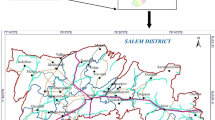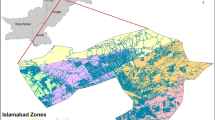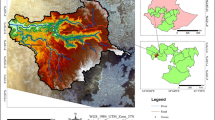Abstract
Interlinking between anthropogenic activities and natural environment can be monitored through the changing pattern of land use dynamics. The present research has been completed with the amalgamation of Geographical Information System (GIS) and statistical techniques in Sundarbans contiguity North 24 Parganas district. This study aims towards unveiling the existing land use/land cover and their recent transformation pattern, rate and their change ‘hotspot’ over the entire 27-year period. In this study, integration of supervised maximum likelihood classification approach (MLCA) and post-classification comparison approach (PCCA) have been used for accumulating the dynamic information regarding the land use dynamics. The result undoubtedly indicates that the built-up area had been drastically increased and vegetation area had been extremely decreased. Transition matrix shows that the maximum agricultural land was converted into a built-up area and water bodies at the same time agriculture have lost maximum area and built up gained maximum area. However, Moran’s I and Getis–Ord (Gi*) statistic indicate that most of the hotspot have been found in built-up area spacially in the western and south-western part of the district. The overall accuracy of the classification is an acceptable range (> 85%). Finally, this study concludes, the present trend of existing land use and land cover should be monitored for the preservation of standing vegetation, control the lopsided growth of built-up area and natural resource to maintain the natural ecosystem. The potential transformation among the land use classes is imperative towards the planning for sustainable land resource management, appropriate land use for the exact purpose, and potential development in this area.













Similar content being viewed by others
References
Abino AC, Kim SY, Jang MN, Lee YJ, Chung JS (2015) Assessing land use and land cover of the Marikina sub-watershed. Philippines. For Sci Technol 11(2):65–75. https://doi.org/10.1080/21580103.2014.957353
Acharya TD, Lee DH, Yang IT, Lee JK (2016) Identification of water bodies in landsat 8 OLI image using a J48 decision tree. Sensor. https://doi.org/10.3390/s16071075
Afify HA (2011) Evaluation of change detection techniques for monitoring land-cover changes: a case study in new Burg El-Arab area. Alexandria Eng J 50(2):187–195. https://doi.org/10.1016/j.aej.2011.06.001
Alqurashi AF, Kumar L (2013) Investigating the use of remote sensing and GIS techniques to detect land use and land cover change. Adv Remote Sens 2:193–204. https://doi.org/10.4236/ars.2013.22022
Amuti T, Luo G (2014) Analysis of land cover change and its driving forces in a desert oasis landscape of Xinjiang, northwest China. Solid Earth 5:1071–1085. https://doi.org/10.5194/se-5-1071-2014
Anderson JR (1971) Land use classification schemes used in selected recent geographic applications of remote sensing. Photogram Eng 37:379–383
Anselin L (1995) Local indicators of spatial association. Geograph Anal. https://doi.org/10.1111/j.1538-4632.1995.tb00338.x
Bai J, Yang L, Chen X, Pu Z (2009) Study on Spatio-temporal changes of land-use at arid oasis city based on remote sensing in 30 years. Jt Urban Remote Sens Event. https://doi.org/10.1109/urs.2009.5137727
Basommi PL, Guan Q, Cheng D (2015) Exploring Land use and Land cover change in the mining areas of Wa East District, Ghana using Satellite Imagery. Open Geosci 7(1):618–626. https://doi.org/10.1515/geo-2015-0058
Bera MM, Mondal B, Dolui G, Chakraborti S (2018) Estimation of spatial association between housing price and local environmental amenities in Kolkata, India Using Hedonic Local Regression. Pap Appl Geograph. https://doi.org/10.1080/23754931.2018.1446354
Bishop Y, Fienberg S, Holland P (1975) Discrete multivariate analysis-theory and practice. MIT Press, Cambridge, p 575
Butt A, Shabbir R, Ahmad SS, Aziz N (2015) Land use change mapping and analysis using remote sensing and GIS: a case study of Simly watershed, Islamabad, Pakistan. Egypt J Remote Sens Space Sci 18(2):251–259. https://doi.org/10.1016/j.ejrs.2015.07.003
Cao X, Feng Y, Wang J (2017) Remote sensing monitoring the spatio-temporal changes of aridification in the Mongolian Plateau based on the general Ts-NDVI space, 1981–2012. J Earth Syst Sci 126(4):1–16. https://doi.org/10.1007/s12040-017-0835-x
Census of India (2011) Office of the registrar general and census commission, Ministry of Home Affairs, Government of India. http://censusindia.gov.in/. Accessed on 22 June 2018
Chakrabortia S, Das DN, Mondala B, Moghadamb HS, Feng Y (2018) A neural network and landscape metrics to propose a flexible urban growth boundary: a case study. Ecol Ind 93:952–965. https://doi.org/10.1016/j.ecolind.2018.05.036
Conchedda G, Durieux L, Mayaux P (2008) An object-based method for mapping and change analysis in mangrove ecosystems. ISPRS J Photogram Remote Sens 63(5):578–589. https://doi.org/10.1016/j.isprsjprs.2008.04.002
Congalton RG (1991) A review of assessing the accuracy of classifications of remotely sensed data. Remote Sens Environ 37(1):35–46. https://doi.org/10.1016/0034-4257(91)90048-B
Datta D, Deb S (2012) Analysis of coastal land use/land cover changes in the Indian Sunderbans using remotely sensed data. Geo-spatial Inf Sci 15(4):241–250. https://doi.org/10.1080/10095020.2012.714104
Dewidar KH (2004) Detection of landuse/land cover changes for the northern part of the Nile delta (Burullus region), Egypt. Int J Remote Sens 25(20):4079–4089. https://doi.org/10.1080/01431160410001688312
Dickinson R (1995) Land processes in climate models. Remote Sens Environ 51:27–38
Dinda S, Das K, Das Chatterjee N, Ghosh S (2018a) Integration of GIS and statistical approach in mapping of urban sprawl and predicting future growth in Midnapore town. Modelling Earth Systems and Environment, India. https://doi.org/10.1007/s40808-018-0536-8
Dinda S, Ghosh S, Das Chatterjee N (2018b) An analysis of transport suitability, modal choice and trip pattern using accessibility and network approach: a study of Jamshedpur city, India. Spatial Inf Res. https://doi.org/10.1007/s41324-018-0223-x
Dolui G, Das S, Satpathy S (2014) An application of remote sensing and GIS to analyze urban expansion and land use land cover change of Midnapore Municipality, WB, India. Int Res J Earth Sci 2(5):8–20
Dong L, Wang W, Ma M, Kong J, Veroustraete F (2009) The change of land cover and land use and its impact factors in upriver key regions of the Yellow River. Int J Remote Sens 30(5):1251–1265. https://doi.org/10.1080/01431160802468248
El-Hattab MM, Bay AQ (2016) Applying post classification change detection technique to monitor an Egyptian coastal zone. Egypt J Remote Sens Space Sci 19(1):23–36. https://doi.org/10.1016/j.ejrs.2016.02.002
El-Kawy ORA, Rød JK, Ismail HA, Suliman AS (2011) Land use and land cover change detection in the western Nile delta of Egypt using remote sensing data. Appl Geogr 31:483–494. https://doi.org/10.1016/j.apgeog.2010.10.012
Erener A, Düzgün S, Yalcinert AC (2012) Evaluating land use/cover change with temporal satellite data and information systems. Proc Technol 1:385–389. https://doi.org/10.1016/j.protcy.2012.02.079
Estoque RC, Murayama Y (2015) Intensity and spatial pattern of urban land changes in the megacities of Southeast Asia. Land Use Policy 48:213–222. https://doi.org/10.1016/j.landusepol.2015.05.017
Fitzgerald RW, Lees BG (1994) Assessing the classification accuracy of multi sources remote sensing data. Remote Sens Environ 47:362–368. https://doi.org/10.1016/0034-4257(94)90103-1
Foody GM (2002) Status of land cover classification accuracy assessment. Remote Sens Environ 80(1):185–201. https://doi.org/10.1016/S0034-4257(01)00295-4
Ganasri BP, Dwarakish GS (2015) Study of land use/land cover dynamics through classification algorithms for Harangi catchment area, Karnataka State, India. Aquatic Proc 4:1413–1420. https://doi.org/10.1016/j.aqpro.2015.02.183
Getis A, Ord JK (1992) The analysis of spatial association by use of distance statistics geographical analysis. Ohio State University Press, Ohio
Ghosh S, Dinda S, Das Chatterjee N, Das K (2018a) Analyzing risk factors for shrinkage and transformation of East Kolkata Wetland. Spatial Inf Res, India. https://doi.org/10.1007/s41324-018-0212-0
Ghosh S, Das Chatterjee N, Dinda S (2018b) Relation between urban biophysical composition and dynamics of land surface temperature in the Kolkata metropolitan area: a GIS and statistical based analysis for sustainable planning. Model Earth Syst Environ. https://doi.org/10.1007/s40808-018-0535-9
Halder A, Ghosh A, Ghosh S (2011) Supervised and unsupervised landuse map generation from remotely sensed images using ant-based systems. Appl Soft Comput J 11(8):5770–5781. https://doi.org/10.1016/j.asoc.2011.02.030
Hall FG, Townsend JR, Engman ET (1995) Status of remote sensing algorithms for estimation of land surface state parameters. Remote Sens Environ 51:138–156
Haque I, Basak R (2017) Land cover change detection using GIS and remote sensing techniques: a spatio-temporal study on Tanguar Haor, Sunamganj, Bangladesh. Egypt J Remote Sens Space Sci 20(2):251–263. https://doi.org/10.1016/j.ejrs.2016.12.003
Harris PM, Ventura SJ (1995) The integration to improve imagery sensed remotely area in an Urban classification. Photogram Eng Remote Sens 61(8):993–998
Hassan Z, Shabbir R, Ahmad SS, Malik AH, Aziz N, Butt A (2016) Dynamics of land use and land cover change (LULCC) using geospatial techniques: a case study of Islamabad Pakistan. Springer Plus https://doi.org/10.1186/s40064-016-2414-z
Huo XN, Li H, Sun DF, Zhou LD, Li BG (2012) Combining geostatistics with Moran’s I analysis for mapping soil heavy metals in Beijing, China. Int J Environ Res Public Health 9(3):995–1017. https://doi.org/10.3390/ijerph9030995
Iqbal MF, Khan IA (2014) Spatiotemporal Land Use Land Cover change analysis and erosion risk mapping of Azad Jammu and Kashmir, Pakistan. Egypt J Remote Sens Space Sci 17(2):209–229. https://doi.org/10.1016/j.ejrs.2014.09.004
Islam K, Jashimuddin M, Nath B, Kumar T (2018) Land use classification and change detection by using multi-temporal remotely sensed imagery: the case of Chunati wildlife sanctuary. Egypt J Remote Sens Space Sci 21(1):37–47. https://doi.org/10.1016/j.ejrs.2016.12.005
Jensen JR (1996) Digital image processing: a remote sensing perspective. Prentice Hall, Englewood Cliffs
Jensen JR, Cowen DJ, Althausen JD, Narumalani S, Weatherbee O (1993) An evaluation of the coast watch change detection protocol in South Carolina. Photogramm Eng Remote Sens 59:1039–1046
Kar R, Reddy GP, Kumar N, Singh SK (2018) Monitoring spatio-temporal dynamics of urban and peri-urban landscape using remote sensing and GIS—a case study from Central India. Egypt J Remote Sens Space Sci https://doi.org/10.1016/j.ejrs.2017.12.006
Khan A, Chatterjee S, Akbari H, Bhatti SS, Dinda A, Mitra C, Hong H, Van DQ (2017) Step-wise Land-class Elimination Approach for extracting mixed-type built-up areas of Kolkata megacity Step-wise Land-class Elimination Approach for extracting mixed-. Geocarto International 6049:1–24. https://doi.org/10.1080/10106049.2017.1408704
Kumar S, Rahakrishnan N, Mathew S (2014) Land use change modelling using a Markov model and remote sensing. Geomat Nat Hazards Risk 5(2):145–156. https://doi.org/10.1080/19475705.2013.795502
Lambin EF (1997) Modelling and monitoring land-cover change processes in tropical regions. Prog Phys Geogr 21(3):375–393
Lillesand TM, Kiefer RW (1994) Remote sensing and image interpretation, 3rd edn. Wiley, USA
Lillesand TM, Kiefer RW, Thomas M (2008) Remote sensing and image interpretation, 6th edn. Wiley, USA
Lu D, Li G, Moran E, Hetric S (2013) Spatiotemporal analysis of land-use and land cover change in Brazilian Amazon. Int J Remote Sens 34(16):5953–5978. https://doi.org/10.1080/01431161.2013.802825
Mantey S, Tagoe ND (2013) Detecting land cover changes in the volta river catchment using GIS and remote sensing methods. Res J Environ Earth Sci 5(7): 418–424. http://maxwellsci.com/print/rjees/v5-418-424.pdf
Mariwah S, Osei KN, Amenyo-xa MS (2017) Urban land use/land cover changes in the Tema metropolitan area (1990–2010). Geol J 82(2):247–258. https://doi.org/10.1007/s10708-015-9672-0
Mondal B, Das DN (2018) How residential compactness and attractiveness can be shaped by environmental amenities in an industrial city? Sustain City Soc. https://doi.org/10.1016/j.scs.2018.05.022
Mondal B, Das DN, Dolui G, (2015) Modelling spatial variation of explanatory factors of urban expansion of Kolkata: a geographically weighted regression approach. Model Earth Syst Environ. https://doi.org/10.1007/s40808-015-0026-1
Mondal B, Dolui G, Pramanik M, Maity S, Biswas SS, Pal R (2017) Urban expansion and wetland shrinkage estimation using a GIS-based model in the East Kolkata Wetland, India. Ecol Ind 83:62–73
Overmars KD, De Koning GHJ, Veldkamp A (2003) Spatial autocorrelation in multi-scale land use models. Ecol Model 164(2–3):257–270
Parsa VA, Salehi E (2016) Spatio-temporal analysis and simulation pattern of land use/cover changes, case study: Naghadeh, Iran. J Urban Manag 5(2):43–51. https://doi.org/10.1016/j.jum.2016.11.001
Pasha SV, Reddy S, Jha CS, Rao PP (2016) Assessment of land cover change hotspots in Gulf of Kachchh, India using multi-temporal remote sensing data and GIS. J Indian Soc Remote Sens 44(6):905–913. https://doi.org/10.1007/s12524-016-0562-9
Paul S, Ziaul S (2017) Detection of land use and land cover change and land surface temperature in English Bazar urban centre. Egypt J Remote Sens Space Sci 20:125–145. https://doi.org/10.1016/j.ejrs.2016.11.003
Pfaffenbichler P, Emberger G, Shepherd S (2008) The integrated dynamic land use and transport model MARS. Netw Spatial Econ 8(2–3):183–200. https://doi.org/10.1007/s11067-007-9050-7
Puyravaud JP (2003) Standardizing the calculation of the annual rate of deforestation Jean-Philippe. For Ecol Manage 177:593–596
Qian J, Zhou Q, Hou Q (2007) Comparison of pixel based and object-oriented classification methods for extracting built-up areas in arid zone. In: ISPRS workshop on updating geo-spatial databases with imagery and the 5th ISPRS workshop on DMGISs, pp 163–171
Rajitha K, Mukherjee CK, Chandran RV, Mohan MM, Mukherjee CK, Chandran RV, Mohan MMP (2010) Land-cover change dynamics and coastal aquaculture development: a case study in the East Godavari delta, Andhra Pradesh, India using multi-temporal satellite data. Int J Remote Sens 31(16):4423–4442. https://doi.org/10.1080/01431160903277456
Rawat JS, Kumar M (2015) Monitoring land use/cover change using remote sensing and GIS techniques: a case study of Hawalbagh block, district Almora, Uttarakhand, India. Egypt J Remote Sens Space Sci 18(1):77–84. https://doi.org/10.1016/j.ejrs.2015.02.002
Roy PS, Meiyappan PK, Joshi MP, Kale VK, Srivastav SK, Srivasatava MD, Behera A, Roy Y, Sharma RM, Ramachandran P, Bhavani AK (2016) Decadal land use and land cover classifications across India, 1985, 1995, 2005. ORNL DAAC, Oak. Ridge, Tennessee, USA. http://dx.doi.org/10.3334/ORNLDAAC/1336
Sewnet A (2015) Land use/cover change at infraz watershed, North western Ethiopia. J Landsc Ecol 8(1):69–83. https://doi.org/10.1515/jlecol-2015-0005
Shalaby A, Tateishi R (2007) Remote sensing and GIS for mapping and monitoring land cover and land-use changes in the North western coastal zone of Egypt. Appl Geogr 27(1):28–41. https://doi.org/10.1016/j.apgeog.2006.09.004
Sikder AH, Begum K, Parveen Z, Hossain MF (2016) Assessment of macro and micro nutrients around brickkilns agricultural environment. Inf Process Agric 3(1):61–68. https://doi.org/10.1016/j.inpa.2016.02.001
Szuster BW, Chen Q, Borger M (2011) A comparison of classification tropical coastal zones cation techniques to support land cover and land use analysis. Appl Geogr 31(2):525–532. https://doi.org/10.1016/j.apgeog.2010.11.007
Tangud T, Nasahara K, Borjigin H, Bagan H (2018) Land-cover change in the Wulagai grassland, Inner Mongolia of China between 1986 and 2014 analysed using multi-temporal Landsat images. Geocarto Int. https://doi.org/10.1080/10106049.2018.1478457
Tulbure MG, Broich M (2013) Spatiotemporal dynamic of surface water bodies using Landsat time-series data from 1999 to 2011. Int J Photogramm Remote Sens 79:44–52. https://doi.org/10.1016/j.isprsjprs.2013.01.010
Wang J, Fu B, Qiu Y, Chen C (2001) Soil nutrients in relation to land use and landscape position in the semi-arid small catchment on the loess plateau in China. J Arid Environ 48:537–550. https://doi.org/10.1006/jare.2000.0763
Yang X, Lo CP (2002) Using a time series of satellite imagery to detect land use and land cover changes in the Atlanta, Georgia metropolitan area. Int J Remote Sens 23(9):1775–1798. https://doi.org/10.1080/01431160110075802
Yi L, Zhang Z et al (2013) Spatial-temporal change of major reserve resources of arable land in China in recent 30 years. Trans Chin Soc Agric Eng 29(6):1–12
Zhenqin S, Wei D, Shaoyao Z (2018) Spatio-temporal pattern changes of land space in Hengduan Mountains during 1990–2015. J Geogr Sci 28(4):529–542
Acknowledgements
The authors acknowledge with special thanks to Mr. Kousik Das (Researcher) for his significant contribution of GIS technical support. The authors are expressed their gratitude to a group of Researcher Mr. Apurba Dinda, Mr. Subrata Ghosh, Mr. Santanu Dinda, Mr. Dipankar Bera and Miss Priyanka Biswas for their remarkable suggestions, valuable information and contribution to continuous motivates regarding this study. The authors would like to thank the anonymous reviewers of this journal for their constructive suggestions to improve the quality of this paper. Finally, the authors also thankful to University Grant Commission (UGC) for financial supporting which is very essential for any research work like that.
Author information
Authors and Affiliations
Corresponding author
Additional information
Publisher's Note
Springer Nature remains neutral with regard to jurisdictional claims in published maps and institutional affiliations.
Rights and permissions
About this article
Cite this article
Bera, S., Das Chatterjee, N. Mapping and monitoring of land use dynamics with their change hotspot in North 24-Parganas district, India: a geospatial- and statistical-based approach. Model. Earth Syst. Environ. 5, 1529–1551 (2019). https://doi.org/10.1007/s40808-019-00601-2
Received:
Accepted:
Published:
Issue Date:
DOI: https://doi.org/10.1007/s40808-019-00601-2




